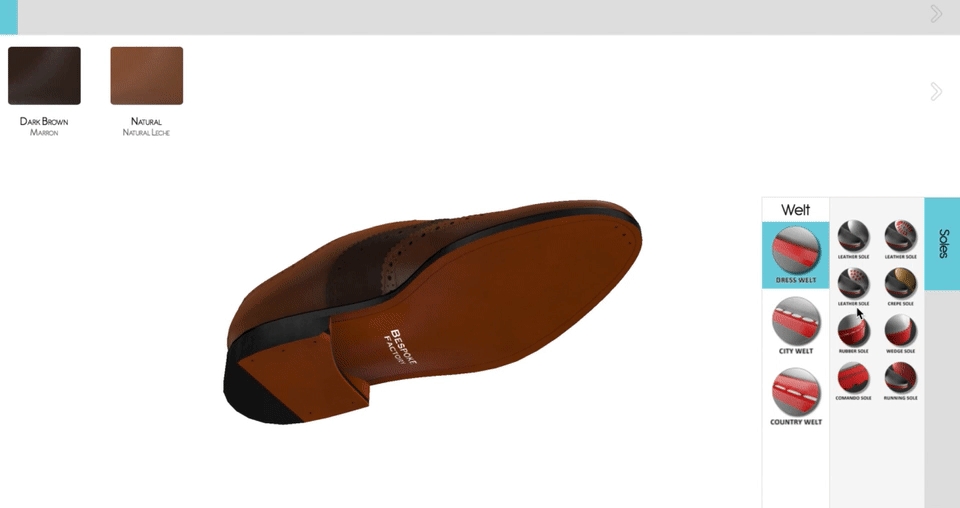Shoe Construction
Construction Methods
There are three basic methods of shoe construction: cementing, blake welting, and goodyear welting. We use both, Blake and Original Goodyear production methods. Each of them has its advantages, and defines how the sole is attached to the upper.
Goodyear Welting
Original Goodyear welting is the oldest, most labor intensive, and most durable of the three methods of construction.
For more than 300 years, the Original Goodyear Welting process has been associated with excellence and superior workmanship. More than 60 craftsmen are involved in the process of manufacturing one of our Goodyear shoes, and they use between 25 and 50 different elements and pieces. All this involves a process with more than 120 handcrafted phases, from beginning to end.
In 1872 Charles Goodyear invented a machine capable of stitching the welt to the insole, thus revolutionizing the quality of footwear worldwide. Due to its longstanding heritage, little needed maintenance, waterproof durability and clean aesthetic, Goodyear method is highly valued in the high-end shoe market.

The welt refers to a strip of leather that is sewn around the perimeter of the upper of the shoe, onto the insole. The outer sole is then sewn to the welt, as opposed to being attached directly to the upper like the Blake stitch method.
The cavity created by the welt between the insole and the outer sole is filled with cork, another natural product which provides insulation, protection, and comfort: as you wear the shoe, the cork filler takes an impression of your foot, like memory foam. This provides unparalleled comfort and support when compared to cheaper forms of manufacturing.
Blake Stitching
Experts recognize Blake-stitched shoes by their soles: the insole is sewn directly to the outsole. Blake-stitched shoes such as loafers don’t have cork bottom fillers or any additional layers of insulation.

A special sewing machine is used for this shoe production method—this machine directly stitches through the outsole, insole and bottom edge of the shoe shaft, connecting them without using welts.
Blake-stitched shoes don’t feature cork bottom fillers or additional layers of insulation, like Goodyear shoes. Loafers are a prime example of this kind of shoe. As opposed to Goodyear-welted men’s shoes, blake-stitched shoes are assembled in fewer steps.
Cementing
Cementing is the fastest, and most common method of attaching the sole of a shoe. Once the upper is shaped and completed around the last, the sole is attached with an adhesive, and no welting is used.
Slippers fall under this category, as well as some other Men Dress rubber soles, like the Running and Sportwedge rubber soles.
Sole Units
From the formal and classic Plain Leather Sole, to the new casual Running Rubber Sole, each one has its own personality.
We offer dozens of different sole units, each sole unit style usually comes in a variety of colors. Sole units are usually restrained to a specific shoe lasts, shoe styles or construction methods.
Choose Between Soles
To alternate between soles, look for the Sole Selection Widget, located on the bottom right of your 3D Designing Tool.

Looking for more sole units?
Then you should definitely look for our custom BULK and RTW (Ready-to-Wear) production programs. We have plenty of different shoe lasts, shoe styles, shoe patterns, sole units… etc for you to choose from.
Shoe Lasts
At Bespoke Factory, every pair of shoes begins with a last — a three-dimensional foot-shaped mold that defines the shoe’s structure, fit, and overall silhouette. The last determines not only how the shoe feels on the foot, but also how it looks — from the curve of the toe to the pitch of the heel.
We use a curated selection of lasts, developed to cover different aesthetic and ergonomic preferences. The choice of last has a significant impact on the final result, especially in men’s dress shoes, where proportions, toe shapes, and visual balance are key to elegance and comfort.
When designing your shoes in the 3D Designing Tool, you’ll be prompted to select the last (if applicable). Some shoe models are compatible with multiple lasts, while others are designed specifically for one.

Our main lasts for men’s dress shoes are designed to capture distinct styles — from classic English round toes to modern chiselled profiles. Each one has its own character and fit:
Zurigo Last: A rounded toe for a traditional English look. It offers a generous fit and timeless proportions, ideal for classic Oxford or Derby styles.
Monti Last: A versatile shape that balances tradition and modernity, featuring a slightly squared toe. Perfect for those seeking classic elegance with a subtle contemporary edge.
Savile Last: Refined and sleek, with a slight chisel toe. This last creates a streamlined silhouette, suitable for formal shoes with a modern aesthetic.
Belgravia Last: Our most distinctive and sophisticated last, combining a chisel toe, narrow waist, and cuban heel. Designed for a refined and elevated profile, emphasizing both style and precision in fit.
Heel Height Options
For Goodyear production, three heel options are available. The standard heel is approximately 26 mm (1 inch). With the higher heel you can add up 8 mm (0.34 inch) in height for a total of 34 mm (1.34 inch). And the pitched heel, with a stilish slant.

Last updated
Was this helpful?